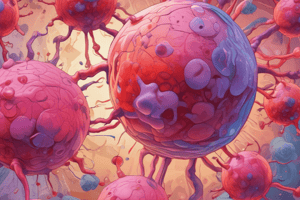Podcast
Questions and Answers
What are the causes of physiologic/pseudoneutrophilia?
What are the causes of physiologic/pseudoneutrophilia?
Exercise, stress, pain, pregnancy
How does pathologic neutrophilia differ from physiologic/pseudoneutrophilia?
How does pathologic neutrophilia differ from physiologic/pseudoneutrophilia?
Neutrophils leave the circulating pool, enter the marginating pool, and then move to the tissues in response to tissue damage in pathologic neutrophilia.
What is the characteristic of Neutrophilic leukemoid reaction (NLR)?
What is the characteristic of Neutrophilic leukemoid reaction (NLR)?
Blood picture mimics that seen in chronic myelogenous leukemia.
What is the range of WBC count increase in Neutrophilic leukemoid reaction (NLR)?
What is the range of WBC count increase in Neutrophilic leukemoid reaction (NLR)?
What is the response of bone marrow in pathologic neutrophilia?
What is the response of bone marrow in pathologic neutrophilia?
What is a characteristic feature of eosinophilia in terms of its association with chronic myelogenous leukemia?
What is a characteristic feature of eosinophilia in terms of its association with chronic myelogenous leukemia?
What is the distinguishing feature between Chronic Myelogenous Leukemia and Leukemoid Reaction in terms of leukocyte alkaline phosphatase score?
What is the distinguishing feature between Chronic Myelogenous Leukemia and Leukemoid Reaction in terms of leukocyte alkaline phosphatase score?
What is the significance of basophilia in relation to Type I hypersensitivity reactions?
What is the significance of basophilia in relation to Type I hypersensitivity reactions?
What causes a decrease in the absolute number of eosinophils resulting in eosinopenia?
What causes a decrease in the absolute number of eosinophils resulting in eosinopenia?
What is the functional abnormality seen in Chronic Granulomatous Disease (CGD) affecting neutrophils?
What is the functional abnormality seen in Chronic Granulomatous Disease (CGD) affecting neutrophils?
Flashcards are hidden until you start studying




